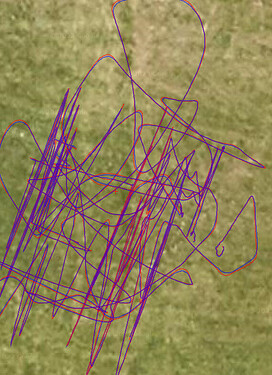Looking at your previous log the X and Y axis vibrations are not too bad, only Z axis vibrations are getting into the danger zone. Z axis vibrations can be the hardest to fix, and in some cases even require design changes.
Send a couple of photos of you flight controller, and surrounding wiring, the copter in general.
In logs check the VibeX,Y,Z values as you have, but also the Clip values.
Clip is a count of the times an accelerometer exceeded it’s physical limits.
Also “on the map” you will see the GPS track (blue) and “POS” tracks (red) diverge - in your case there’s not a lot of divergence at all, indicating X and Y axis are reasonably good.
The X and Y axis vibrations cause error in the horizontal position and this will become apparent with “GPS Glitch” errors and similar as GPS position and IMU-calculated position start to disagree.
X and Y axis vibrations could be:
- prop balance, a motor bent shaft or bad bearings
- wiring pulling on the flight controller - either stretched tight, or bunch of wires putting weight on the FC
- something touching the FC
- loose wiring or items
- antivibration system may be disproportionate in one direction
- flexible arms and frame
Z axis vibrations make the copter think it’s falling and so it attempts to gain altitude (a fly-away). Eventually the disparity between baro, GPS and IMU becomes too much, the copter realises what is happening and declares a vibration failsafe. The copter will try to descend despite the accels probably saying it is still rising.
The Z axis vibrations can be caused by everything mentioned for X/Y axis, plus:
- props passage over arms, especially if arms are bulky with ESCs attached externally
- props passage over baseplate
- prop wash over the flight controller
- frame flexibility and resonance - worth a second mention!
Apart from excessive levels of vibrations causing direct and obvious issues to your airborne copter, “medium” levels of vibration will prevent proper tuning. For example Autotune will not produce a useful result. You will be forever chasing problems and trying to improve tuning.
Some flight controllers have accelerometers with a greater range. Generally you will know if you have those accelerometers because you would have paid a high price for your FC and likely sort out such a flight controller. It may be that vibrations of 30 m/s/s are well within an acceptable range. However the aircraft should not be operated in that elevated range of vibrations - more it should be viewed as a greater margin for error should something go wrong or come loose during flight.
Aircraft with an internal combustion engine and/or generator could be more reliable with such a flight controller.
A Cube Orange is a good choice, but even these can have a resonance problem with the internal damping and whatever is causing the vibrations.
Wiring is something that often gets overlooked - it should all be secured to the frame. Leave just enough flexibility where wiring needs to connect to the flight controller, so that vibrations are not transferred.
